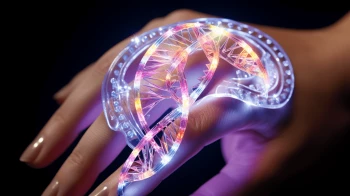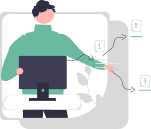Gel nails have revolutionized the world of manicures, offering a lasting and vibrant alternative. However, beneath the glossy surface lies a potential threat to your health – the UV dryers commonly used in gel curing may be causing harm to your DNA.
The Allure of Gel Nails
Gel nails have gained immense popularity due to their durability and aesthetic appeal. The extensive range of colors and long-lasting finish make them a favorite among beauty enthusiasts. However, the convenience of gel nails comes at a cost that many may not be aware of.
The Role of UV Dryers
Central to the gel curing process is the use of UV dryers. These devices utilize ultraviolet light to harden the gel, ensuring a robust and enduring manicure. While the efficiency of UV dryers is undeniable, the potential risks associated with prolonged exposure to UV radiation raise concerns.
Understanding UV Radiation
Before delving into the DNA connection, it's crucial to understand the nature of UV radiation. Differentiate between UVA and UVB rays, shedding light on how these wavelengths can impact the skin and, more significantly, the genetic material within our cells.
The DNA Connection
Recent studies suggest a concerning link between UV exposure from gel nail dryers and DNA damage. Unravel the scientific intricacies of how UV rays can interact with DNA molecules, potentially causing mutations. This newfound awareness prompts a reevaluation of the health risks associated with regular gel nail treatments.
Health Risks and Symptoms
1. Elevated Risk of Skin Cancer:
- Explanation: Prolonged exposure to UV radiation, especially from UV dryers used in gel nail treatments, has been associated with an increased risk of skin cancer.
- Why it Matters: Understanding this risk prompts individuals to reconsider the frequency and duration of their gel nail sessions, prioritizing skin health.
2. Premature Aging:
- Explanation: UV exposure accelerates the aging process of the skin, leading to premature wrinkles, fine lines, and a loss of skin elasticity.
- Why it Matters: Beyond immediate health concerns, individuals are encouraged to assess the long-term effects of UV exposure on their skin's appearance and overall aging.
3. Symptoms of Excessive UV Exposure:
- Explanation: Highlight physical symptoms that may indicate overexposure to UV radiation during gel nail treatments.
- Examples:
- Skin Redness: Excessive redness or irritation may signal that the skin has absorbed too much UV radiation.
- Dryness or Peeling: Dehydration and skin peeling may indicate damage from prolonged exposure.
- Pigmentation Changes: Noticeable changes in skin color, such as dark spots or uneven pigmentation, can be warning signs.
4. Empowering Recognition of Warning Signs:
- Explanation: The goal is to empower individuals to recognize early signs of UV damage, encouraging proactive health choices.
- Importance: Early detection allows for timely adjustments in gel nail routines, reducing the risk of long-term health consequences.
Mitigation Strategies
1. UV-Blocking Gloves:
- Use UV-Blocking Gloves: Invest in specialized UV-blocking gloves designed to shield hands and fingers during gel nail curing.
- Benefits: These gloves provide a protective barrier, reducing direct UV exposure to the skin and minimizing the risk of DNA damage.
2. Minimize Exposure Time:
- Time Management: Limit the time your hands are exposed to the UV dryer during gel nail sessions.
- Why it Matters: By reducing exposure time, you decrease the cumulative impact of UV radiation on your skin and DNA, mitigating potential risks.
3. Explore Alternatives:
- LED Curing Lamps: Consider using LED curing lamps as an alternative to traditional UV dryers.
- Benefits: LED lamps cure gel polish more efficiently, often requiring shorter exposure times and emitting less UV radiation.
4. Apply Sunscreen:
- Use Broad-Spectrum Sunscreen: Prior to gel nail sessions, apply a broad-spectrum sunscreen on your hands.
- Protection: Sunscreen acts as an additional layer of protection, reducing the penetration of harmful UV rays into the skin.
5. Regular Skin Checks:
- Self-Examinations: Conduct regular self-examinations of your skin, especially on the hands and fingers.
- Early Detection: Being vigilant about changes in skin texture or color enables early detection of any potential issues, allowing for prompt action.
6. Hydrate and Moisturize:
- Keep Skin Hydrated: Well-moisturized skin is more resilient to damage.
- Prevention: Regularly hydrate your hands with a nourishing moisturizer to reduce the risk of dryness and peeling associated with UV exposure.
7. Consult a Professional:
- Seek Professional Advice: Consult with a nail technician or dermatologist for personalized advice on minimizing UV exposure during gel nail treatments.
- Individualized Approach: Professionals can offer recommendations tailored to your skin type and specific needs.
Why it's Important:
Implementing these mitigation strategies empowers individuals to enjoy the aesthetic benefits of gel nails while proactively safeguarding their health. By incorporating protective measures, minimizing exposure, and exploring alternative curing methods, individuals can strike a balance between beauty and well-being. These strategies ensure that the allure of gel nails doesn't compromise the health of your skin and DNA.
In Conclusion
By fostering an understanding of the nuanced relationship between beauty and health, readers are empowered to make choices that align with their preferences. The intricate world of gel nails and UV dryers, once shrouded in glamour, now invites a thoughtful reevaluation. This is not a call to abandon beauty rituals but an invitation to elevate them – to transform routines into acts of self-care, where informed decisions become the foundation of a healthier and more radiant future.






